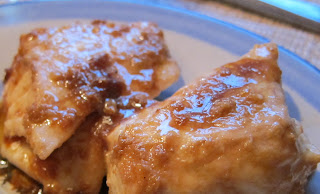Don asserted a few weeks ago that the main course for any Easter dinner had to feature something that ends in “am.” He was hoping for lamb.
But I amended the rule to include things that had the “am” sound anywhere in the word, and so, cooked salmon.
We started with radish slices sitting on a bed of creme fraiche with radish sprouts on top. I found tamari black sesame brown rice crackers at the local bakery, and they were crispy, salty and perfect.
If you haven't ever tried olives with garlic cloves inside, you should. Buy them from a grocery store olive bar though and not the jarred variety -- the garlic in the former is crunchy (but not at all overpowering in case you're worried) while the garlic in the latter is soft and mushy.

I marinated the salmon in orange juice and ginger. It could have used a bigger kick --maybe with some lemon juice and garlic. Poaching the salmon in the microwave was quick and easy (same technique as my halibut recipe). On top of the salmon was a relish with orange pieces, ginger, red onions (with some extra radish spouts tossed on top).
Dessert was lemon meringue pie--no comment necessary!











































